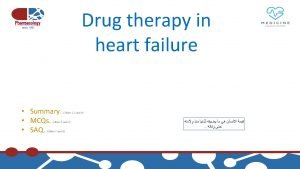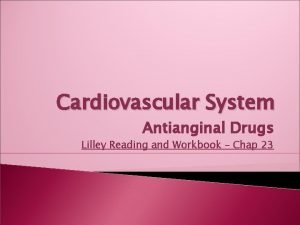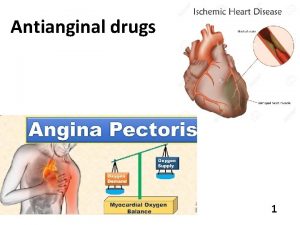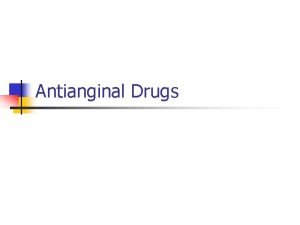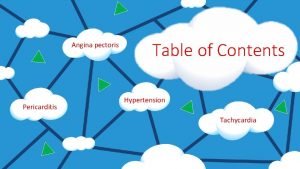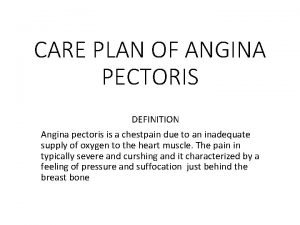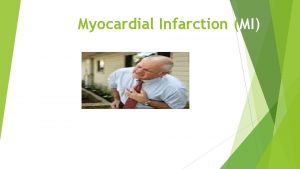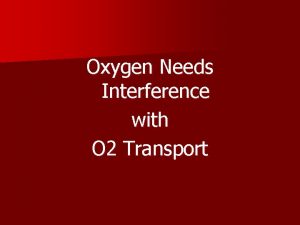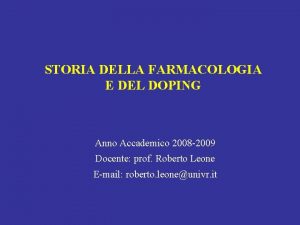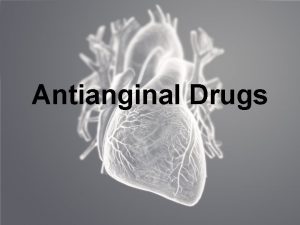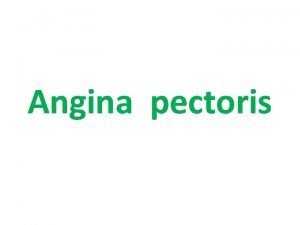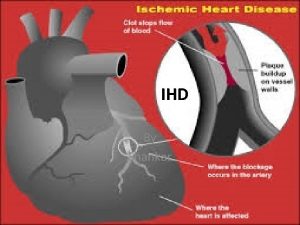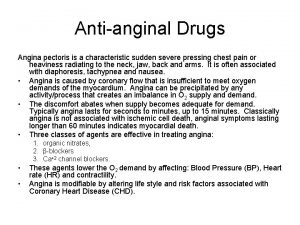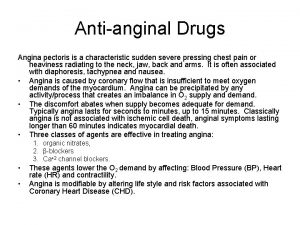Coronary vasodilators Antianginal drugs Angina pectoris is a










- Slides: 10


Coronary vasodilators Antianginal drugs Angina pectoris: is a clinical syndrome characterized by paroxysm of pain in the anterior chest caused by insufficient coronary blood flow and/or inadequate oxygen supply to the myocardial muscle. Causes: (1) Atherosclerosis. (2) Vasospasim. There are three groups of drugs used for treatment of angina: Nitrates/nitrites. Beta-adrenergic blocking agents. Calcium channel blocking agents.

Nitrates/nitrites: - Nitrates/nitrites - Action: direct relaxation of blood vessels and smooth muscles vasodilatation O 2 requirements. - Relaxation of smooth muscles of coronary arteries coronary vasodilatation blood supply to the myocardium. - Relaxation of arteries and veins BP workload in the heart.

Objectives of treatment: Treatment of anginal attack and thus relief pain. Prophylactic treatment to prevent or delay the occurrence of MI. Prolongs intervals between attacks. Indications: Prophylaxis and treatment of acute angina pectoris. Treatment of chronic angina pectoris. Treatment of hypertension associated with MI or CHF. Nitroglycerin ointment for treatment of Raynaud’s disease.

Contraindications: Sensitivity to nitrates Hypotension. Severe anemia. Hypotension. Head trauma. Cerebral hemorrhage.

Side effects: Headache, syncope, dizziness. Postural hypotension, transient flushing, and palpitation. Topical application may lead to dermatitis. Drug interaction: Antihypertensive agents, Beta-adrenergic blocking agents, and calciumchannel blocking agents (they may lead to additive hypotension).

Dosage: there are several forms available: Sublingual: Cordil 5 mg PRN. PO: Isotard 20 – 40 mg twice a day. Topical: available as patches or ointment. Parental (IV infusion).

Nursing considerations: 1. 2. 3. 4. 5. Medications should be taken on an empty stomach. Carry sublingual tablets in a glass bottle, tightly capped. If anginal pain is not relieved in 5 minutes by first sublingual tablet, to take up to 2 more tablets at 5 minutes interval. If pain has not subsided 5 minutes after the 3 rd tablet, client should be taken to the emergency room as this case could be an infarction (MI) and not angina. Take sublingual tablets 5 -15 minutes prior to any situation likely to cause anginal pain such as climbing stairs. Take sublingual tablets while sitting to avoid postural hypotension.

Isosorbide dinitrate: Present in the forms of capsules; chewable, sublingual, tablets. Trade names: Isoral, Cordil, Isotard. Class: coronary vasodilator. Dosage forms: caps 20 -40 mg, tabs 20 -40 mg. Uses: Tabs for only prophylaxis of anginal pain. Chewable, sublingual to terminate acute attack and relieve acute pain. Esophageal spasm. Side effects: Headache, hypotension.

Dosage: Sublingual: acute attack 2. 5 -5 mg Q 2 -3 hrs. Oral caps/tabs: 5 -20 mg Q 6 hrs. Extended release tabs: 20 – 80 mg Q 8 -12 hrs. Note: Isosorbide mononitrate given for patients with liver impairments.
